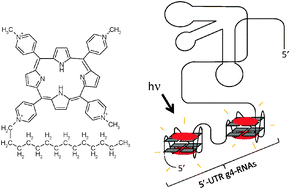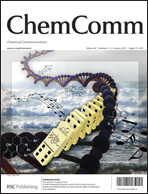Photoactivated cationic alkyl-substituted porphyrin binding to g4-RNA in the 5′-UTR of KRAS oncogene represses translation†
Abstract
The KRAS transcript is characterized by a 192-nt 5′-UTR containing repetitive runs of two-guanines which can fold in several G-quadruplexes. These folded structures have a high affinity for the cationic porphyrin tri-meso(N-methyl-4-pyridyl), meso(N-tetradecyl-4-pyridyl) porphine (TMPyP4-C14), which efficiently penetrates cell membranes. Upon photoactivation TMPyP4-C14 induces a dramatic down-regulation of oncogenic KRAS and cell growth arrest in pancreatic cancer cells.


 Please wait while we load your content...
Please wait while we load your content...